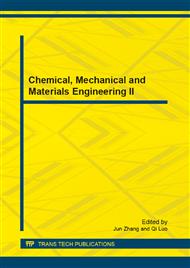p.121
p.127
p.134
p.140
p.146
p.151
p.157
p.161
p.165
Prokaryotic Expression and Identication on the 20kDa Protein Gene of Mycobacterium paratuberculosis
Abstract:
The gene encoding 20kDa protein gene from Mycobacterium paratuberculosis C-2, chromosomal DNA was amplified by using polymerase chain reaction (PCR), the PCR product was approximately 520bp DNA segment. The PCR product was cloned into pGEM-T vector and the cloning plasmid pGEM-T-20 was constructed successfully. The purified 20kDa protein gene was subcloned into the expression vector pET28a(+), and the prokaryotic expression plasmid pET28a-20 was constructed. Plasmid containing pET28a-20 was transformed into competence Escherichia coli BL21 (DE3). The bacterium was induced by isopropyl-β-D- thiogalactopyranoside (IPTG) and its lysates were loaded directly onto sodium dodecyl sulphate polyacrylamide gel electrophoresis (SDS-PAGE), approximately 23kDa exogenous protein was observed on the SDS-PAGE. The protein was analyzed by using Western-blotting. The results indicated that the protein was of antigenic reactivity of M. paratuberculosis. The results were expected to lay foundation for further studies on the subunit vaccine and DNA vaccine of 20kDa protein gene in their prevention against bovine paratuberculosis.
Info:
Periodical:
Pages:
146-150
Citation:
Online since:
May 2013
Price:
Сopyright:
© 2013 Trans Tech Publications Ltd. All Rights Reserved
Share:
Citation:


